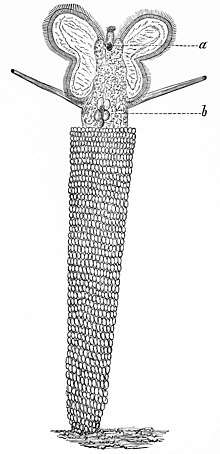Floscularia ringens
Floscularia ringens is a species of rotifer belonging to the subclass Monogononta, which resides in a tube that it builds using many little circular pellets consisting of bacteria and small pieces of detritus.[1]
| Floscularia ringens | |
|---|---|
 | |
| Scientific classification | |
| Kingdom: | |
| Phylum: | |
| Class: | |
| Order: | |
| Family: | Flosculariidae |
| Genus: | Floscularia |
| Species: | F. ringens |
| Binomial name | |
| Floscularia ringens | |
The name Floscularia was inspired by the flower-like shape of the organism.[2]
Floscularia ringens grows to around 1.5 millimeters long and resides in freshwater locations, where it makes its small tube by connecting to the bottom of the leaves of water lilies.[3] It retreats into its tube when it is bothered.[4]
Feeding behavior
Floscularia ringens brings in food using water currents made with quickly moving cilia.[5] The quick, simultaneous movement of the two lobes consisting of cilia looks like little turning wheels.[5]
Reproduction and development
Adult Floscularia ringens make parthenogenetic eggs that are kept in the tube.[1] After the eggs hatch, the young stay in the maternal tube for a little time to finish developing before swimming off.[1] A young Floscularia ringens has a cone-shaped body, short foot, little corona, and mastax with trophi, but it still seems to not be able to eat.[1] In less than one day, the young Floscularia ringens makes a lasting connection to a substrate.[1] Its corona now has four lobes, and the foot lengthens.[1] After the corona develops the Floscularia ringens starts to eat through making currents, and it also begins to create its tube.[1]
Moment of fame
A close-up image of Floscularia ringens came first place in the 2011 Olympus BioScapes Digital Imaging Competition that presents movies and photographs of life science images.[6] The photograph depicts Floscularia ringens' feeding method, showing its quickly moving cilia which pulls in water consisting food.[7] Charles Krebs, the photographer of this image of Floscularia ringens, had his picture chosen out of the 2,000 submissions to the 2011 competition, earning him Olympus imaging equipment valued at $5,000.[6] Charles Krebs captured his photograph of Floscularia ringens using a method called differential interference contrast microscopy.[7]
References
- Diego Fontaneto, Giulio Melone & Robert L. Wallace (2003). "Morphology of Floscularia ringens (Rotifera, Monogononta) from egg to adult". Invertebrate Biology. 122 (3): 231–240. doi:10.1111/j.1744-7410.2003.tb00087.x.
- "Floscularia - one more famous marvel of pond life"
- "BioScapes: the beauty of nature"
- "LM of sessile Floscularia ringen"
- "Floscularia Ringens"
- "Tiny critter becomes a big wheel"
- ""Mr. Charles Krebs"". Archived from the original on 2013-03-12. Retrieved 2013-05-07.